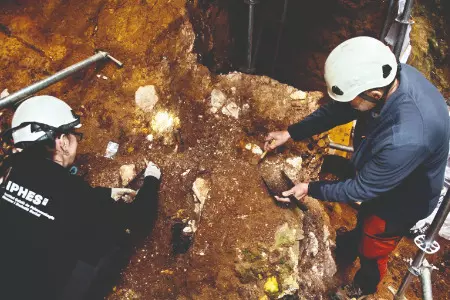Fossils of facial bones unearthed in a cave indicate ‘oldest known human’

sydney: In a system of caves in the Atapuerca Mountains in Spain, nearly 50 years of systematic archaeological excavations have unearthed evidence of increasingly ancient human occupation.
The result of this systematic work has yielded human traces stretching from the Bronze Age to hundreds of thousands of years into the past – before modern humans like us (Homo sapiens) even existed.
In new research published in Nature, our team shares another find from Atapuerca: the earliest human remains ever found in Western Europe. We discovered fragments of face bones from a species of extinct human previously unknown in this region, dating from between 1.2 million and 1.4 million years ago.
Sima del Elefante
Back in 2022, during our annual field season, our team unearthed a series of bone fragments from a cave called Sima del Elefante (Pit of the Elephant). The fragments are from the left side of the mid-face of an adult human.
In 2008, a human jawbone more than 1.1 million years old had been found at the same site. The new fragments were found around two metres deeper than the jawbone, which suggests they are even older.
Since the discovery, our team has spent more than two years meticulously studying the remains. We wanted to find out which species of ancient human they belonged to, and understand the lives and environment of these long-extinct cousins.
Evidence from the Gran Dolina site, not far from Sima del Elefante, has shown that a species of ancient humans known as Homo antecessor once populated the Atapuerca region. Direct dating of H. antecessor fossils has shown they lived in the region around 850,000 years ago.
The first question we asked about the new face fossil was whether it belonged to H. antecessor. This species had a relatively modern-looking face: quite vertical, rather than the strongly sloping shape often seen in older species.
The shape of our new face bones was not a match for H. antecessor, so what could it be?
We compared the remains to those of other earlier hominin groups, including ones from the Dmanisi site in the Republic of Georgia, which have been dated to around 1.8 million years ago. The Sima del Elefante face differs from the Dmanisi hominins, especially in the area around the nose.
However, it does share some similarities with Homo erectus, the first human species to spread from Africa to Asia, beginning around 2 million years ago, and now also found in Western Europe. The similarities include the lack of a projecting nose and the forward-projection of the midface.
However, key details about the Sima del Elefante face are still missing. For now, we are classifying it as Homo aff. erectus, which means it appears to be closely related to H erectus but lacks some
defining features. Agencies
Cleaning 880 tons of melted fuel debris
A remote-controlled extendable robot with a tong had several mishaps including equipment failures before returning in November with a tiny piece of melted fuel from inside the damaged No. 2 reactor.
That first successful test run is a crucial step in what will be a daunting, decades-long decommissioning that must deal with at least 880 tons of melted nuclear fuel that has mixed with broken parts of internal structures and other debris inside the three ruined reactors.
Akira Ono, chief decommissioning officer at the Tokyo Electric Power Company Holdings, which manages the plant, says even the tiny sample gives officials a lot of information about the melted fuel. More samples are needed, however, to make the work smoother when bigger efforts to remove the debris begin in the 2030s.
A second sample-retrieval mission at the No. 2 reactor is expected in coming weeks.
Operators hope to send the extendable robot farther into the reactor to take samples closer to the centre, where overheated nuclear fuel fell from the core, utility spokesperson Masakatsu Takata said.
He pointed out the target area as he stood inside the inner structure of the No. 5 reactor, which is one of two reactors that survived the tsunami. It has an identical design as No. 2.
Hard to see, breathe
Radiation levels are still dangerously high inside the No. 2 reactor building, where the melted fuel debris is behind a thick concrete containment wall. Earlier decontamination work reduced those radiation levels to a fraction of what they used to be.
In late August, small groups took turns doing their work helping the robot in 15- to 30-minute shifts to minimize radiation exposure. They have a remotely controlled robot, but it has to be manually pushed in and out.
“Working under high levels of radiation (during a short) time limit made us feel nervous and rushed,” said Yasunobu Yokokawa, a team leader for the mission. “It was a difficult assignment.”



